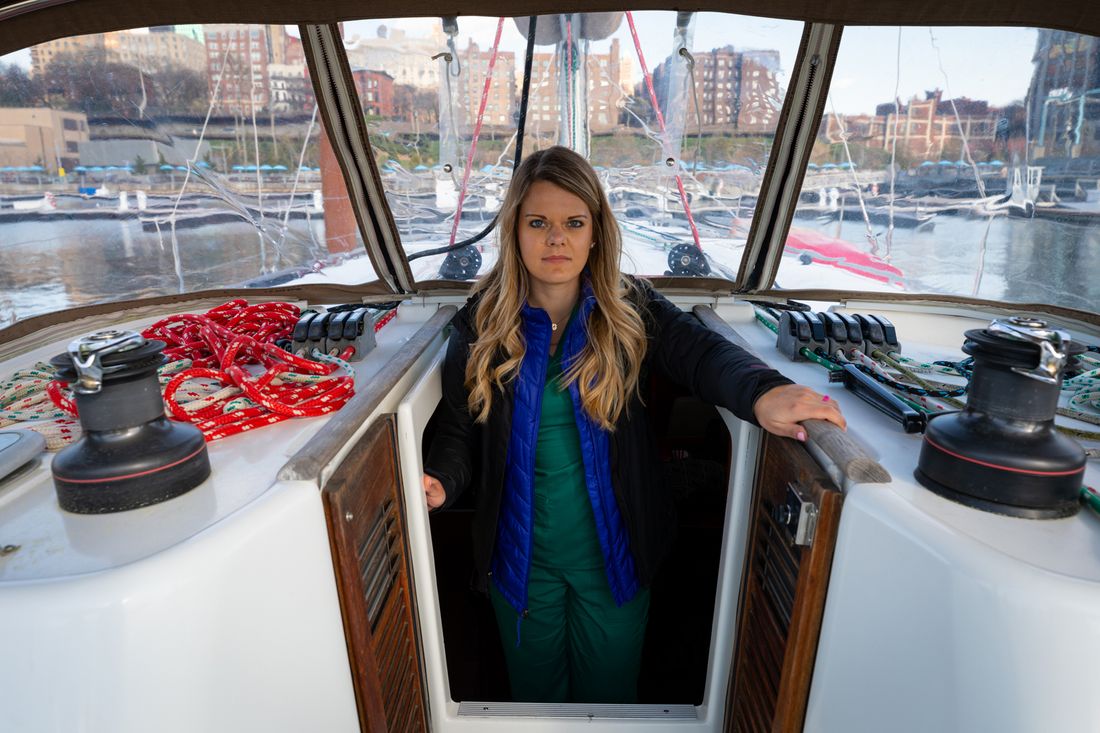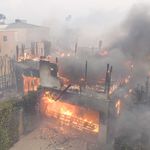
We’re committed to keeping our readers informed.
We’ve removed our paywall from essential coronavirus news stories. Become a subscriber to support our journalists. Subscribe now.
On Easter Sunday, as the noon sun bore down on New York City in bloom during what is surely its saddest spring in a century, a 50-foot white-hulled sailboat named Turning Point arrived in New York Harbor to berth in an otherwise empty marina in Brooklyn Bridge Park. On deck and ready to throw a line to the waiting dockhands was 26-year-old Rachel Hartley, an ICU nurse who had just sailed the nearly 250 miles from Hampton, Virginia — keeping watch overnight with her husband, Taylor, over the 34-hour passage — and ready to make the boat her home for the next two months. She is one of thousands of out-of-town medical professionals answering the call to provide reinforcements to the city’s hospitals.
Hartley, who has been a nurse since 2015 and spent two years working in an ICU, was working in surgical pre-ops in Lynchburg, Virginia, when, in early March, her hospital began to cancel all but the most urgent surgeries. Then, for several weeks, she said not a day went by when she was not “called or emailed or texted by one of the nurse-staffing companies” seeking people with intensive-care experience for coronavirus epicenters like New York: “Holy cow! There was such a need!”
She thought: “I’m not being utilized and I have training and skills to offer … [Because] my true bread and butter is critical care.” By then, she had already treated a few COVID-19 patients and her hospital was “bracing for a surge,” but she knew it would be “nothing like New York.” She gave her two weeks notice, and said good-bye to her colleagues. Since she and her husband, Taylor Hartley, a college recruiter and photographer (he took these pictures), owned a boat, they decided they’d sail up to New York in it to give her a place to stay.
“There are nurses coming out of the woodwork, out of retirement, out of their small towns, to travel to the epicenter of the pandemic to help out,” says Patrick Overby, a medical recruiter with Fusion Medical Staffing, based in Omaha, Nebraska, who worked with Hartley. Overby has worked more intensely the last six weeks than he ever has (from home of course: He talked to me while “sitting in the basement at a card table in my wife’s crafts room.”) Hartley is just one of 200 nurses his company estimates it has already placed in New York alone as he and his colleagues work to fill 15,000 posts for all kinds of medical professionals needed in the hot spots across the country.
Hartley convinced her former colleague Tom Huling — a nurse, paramedic, and firefighter from Columbus, Ohio — to quit his job and travel to New York too. (He drove, but will be staying with them on board the boat.) Their paid two-month tour of duty as ICU nurses will be at NYU Langone’s campus in Sunset Park, Brooklyn. The Hartleys’ friend Emily Chafins, a physician’s assistant, joined them as well (her hospital assignment is pending).
Rachel’s husband is captain of the boat. “I am most excited about being able to support the three of them,” he said, and to do what he can on the boat “to provide a nice set-up for them to come home to.”
The city’s boating community is pitching in too. Local sailor Carla Murphy posted about Hartley’s journey in the Facebook group Sailors of New York, and within an hour the recently opened ONE°15 Brooklyn Marina donated dockage for two months (normally more than $11,000) to the Hartleys. The marina restaurant is feeding the Turning Point crew — alongside FEMA-contracted ambulance squads — through its GoFundMe campaign. (Aside from Coast Guard, law enforcement, and emergency boats every now and then, Turning Point is the only vessel in the marina these days.) Other sailors and local companies have donated support and equipment.
The foursome’s long stay will have its challenges. Below deck, the boat is carved into a warren of small berths and the main cabin is less than 15 feet across. The group is following strict hygiene protocols and Hartley’s former work colleagues in Virginia donated a lot of PPE materials, but if anyone falls ill, the sick party will have to isolate and, Taylor said, “We will send food down the hatch.”
Also, the four don’t know each other all that well. Taylor and Huling had met briefly just once before and Chafins met Huling for the first time on this journey.
And none of them has ever lived in or even spent much time in New York. Huling had never even laid eyes on the city. Chafins has visited once. Of Hartley’s two short trips to the city, she said, “I have 100 percent been a tourist.” Though, as it happens, she was in Times Square on May 18, 2017, when a man named Richard Rojas drove deliberately onto the crowded sidewalk. She stabilized a young woman who’d been hit until paramedics arrived. “It was like a horror film, all these hundreds of people were screaming and running from the scene,” Hartley recalled. “Everyone else was running away but me being a nurse, I ran towards.”
And she’s doing it again. We spoke after her first shift in Brooklyn: “What I expected was we were probably going to be flying by the seat of our pants and all the patients would be crazy sick, and that’s all true,” she said. It was hard to communicate with her new colleagues with everyone layered up in PPE, and hard also to navigate the spaces that she said have been “jerry-rigged” to accommodate as many patients as possible. “The nurses that are permanently here are so exhausted and worn out,” she said. “This is why I’m here.” She’s met about 50 nurses who have traveled to the city from as far away as Pennsylvania, Indiana, Tennessee, Georgia, Texas, Hawaii, and California.
“It was what I expected, and I think worse also.” “Sobering” is a word she uses more than once. “I can’t count how many code blues and rapid responses were called,” she said, and what surprised her most is how many of her patients are young and otherwise healthy people who are now “all intubated, sedated, and chemically paralyzed.”
“It really makes me hope and pray the public takes things seriously,” she said.
By the time her overnight shift ended, the sun had just risen, but it was too misty a morning to see its rays. She’d walked in fresh scrubs from the hospital to catch the ferry, a lone passenger with her head against the window, looking up at that famous skyline. Walking from the ferry landing to the marina, where her husband would clamber from their boat to greet her on the dock with her toiletries and her towel so that — without contaminating the main cabin — she could wash up again in the marina’s showers, Hartley heard someone calling out to her.
“It was a lady out walking her dog.” Glassy-eyed and somber in her scrubs, Hartley turned. “She just yelled at me, ‘God bless you, honey!’”































